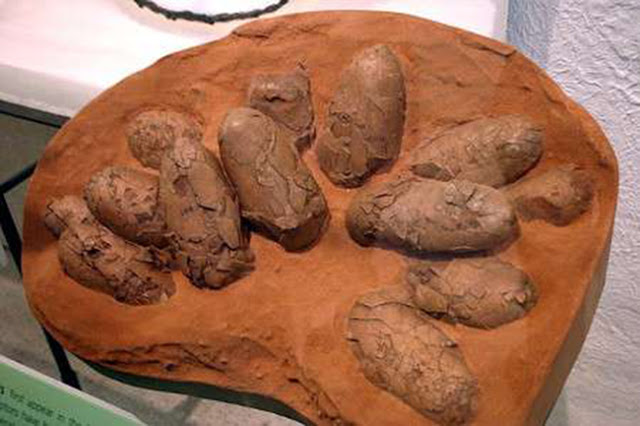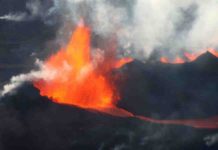
Horned dinosaurs (ceratopsians) just can’t catch a break when it comes to their fossilized eggs. The first purported examples turned up in Mongolia during the 1920s, attributed to Protoceratops. A few unlucky “Protoceratops” eggs were fossilized next to the jaws of another dinosaur (Oviraptor, which means “egg thief”), presumably in the act of raiding the nest. Decades later, it turned out that the nest raider was probably the parent Oviraptor safeguarding its own eggs. Study of other eggs associated with embryos showed that everything we thought were Protoceratops eggs were actually from Oviraptor and related animals!
So, as a horned dinosaur fancier, I was pretty excited when an authentic ceratopsian egg and embryo were announced in 2008. Amy Balanoff and colleagues described an egg from Late Cretaceous-aged rocks (~90 to 70 million years old; the exact date is uncertain), which had a few tiny bones poking out of the end. Dinosaur embryo! Computed tomography (CT, a technique using x-rays to peek inside objects) revealed more of the bones, including two skull bones that appeared especially ceratopsian. One bone was identified as a predentary, the scoop-shaped bone at the front of the lower jaw used to lop off plants. The other skull bone appeared to be a quadrate, one of the bones of jaw joint. The predentary in particular narrowed identification to a plant-eating dinosaur (the bone doesn’t occur in theropods such as Oviraptor), and the shape of the quadrate further suggested a horned dinosaur. Yamaceratops (closely related to Protoceratops) is a ceratopsian found in the same rock layers and was thought to be the likely source.
One puzzle, though, was the eggshell itself. Eggshell appears simple to the naked eye, but the microscopic details can be pretty distinctive to the egg producer. The number of layers within the eggshell, for instance, and the arrangements of the minerals that make up the layers, vary from group to group. Some eggshells, such as those of turtles, have but a single layer. The Mongolian ceratopsian eggshell had three layers–a characteristic usually associated with theropod dinosaurs (Oviraptor and early birds, for instance). But, given the presence of ceratopsian bones in the egg and the fact that nobody knew what ceratopsian eggshell should look like, this suggested that horned dinosaurs had eggshell that converged on that of theropods. So, the three-layered eggshell evolved multiple times across dinosaurs.
But…things are never that simple. A new paper in PLOS ONE, including the two senior authors from the original work, proposes a new identification. Ceratopsian no more…now it’s a bird!
Incredulity might be the first reaction of many people. How could you mix up a wingy, feathered bipedal thing with a big plant-munching quadruped? It should be obvious to even a casual observer, right?
Actually, no. Embryonic bones (those inside of an egg) can look vastly different from those of their adult counterparts, because many characteristic features don’t appear until the animal is out of the egg. As a result, it can be tough to orient and identify bones correctly. Additionally, even high-tech imaging (such as CT scanning) has a certain degree of interpretation to it. The researcher who digitally separates bone from rock has to make judgement calls all of the time. Is this bone or rock that looks like bone? Are these two bones stuck together, or one bone with a crack down the middle? Even under the best of circumstances, there is room for ambiguity.
Given what everyone knew at the time, and in light of the possible predentary and other bones, “ceratopsian” was a reasonable hypothesis as presented in the initial publication. But a second look at the data never hurts. Movies of the CT scans were posted online, allowing other researchers to take a peek. Undoubtedly following some pretty interesting discussions, two of the original authors (Amy Balanoff and Mark Norell) joined dino-bird expert Dave Varricchio (lead author on the new paper) to present a re-interpretation of all of the data.
It turns out that the egg was turned around in the original interpretation; the front of the animal could be identified instead as the back. Thus, many of the bones were mis-oriented in the original paper. What was thought to be a ceratopsian humerus turned out to be a bird femur, a tibia turned into an ulna, and so on. As described above, this is a pretty easy “mistake” to make, given how nondescript many embryonic bones are. The quadrate and predentary are more mysterious–the former may be a pelvic bone, but the true identification of the “predentary” is highly debatable. Perhaps it’s part of a vertebra, or a wishbone, or something else. In any case, when reoriented, most of the bones are a better match for bird than ceratopsian.
If the Gobi egg is from a bird, that also solves solves the problem of the three-layered eggshell. No longer distributed across dinosaurs, this type of eggshell is now firmly restricted to theropods (including many birds). Additionally, this embyro provides another rare data point for studying the embryology of ancient birds. Previous discoveries have shown some key developmental differences between non-avian dinosaurs, early birds, and modern birds, so the newly identified Gobi bird egg has an important story to tell on how these differences evolved over time.
One mystery remains–what do horned dinosaur eggs and embryos look like? There are undoubtedly unidentified examples in a museum drawer or outcrop. A nest of little Triceratops sure would help right about now.
Reference:
“Reidentification of avian embryonic remains from the Cretaceous of Mongolia.” PLoS ONE 10(6): e0128458. DOI: 10.1371/journal.pone.0128458
Note : The above story is based on materials provided by Public Library of Science.










